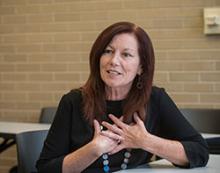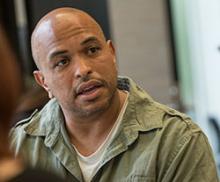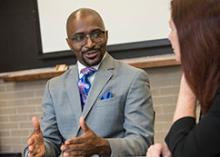Collaborating with the Community to Reduce Violence
How understanding the perspective of the community benefits researchers
VOLUME 24 | ISSUE 1 | WINTER 2017
A leader in the field of studying violence prevention is Deborah Gorman-Smith, the Emily Klein Gidwitz Professor at SSA. She is the Principal Investigator and director of the Chicago Center for Youth Violence Prevention (CCYVP), one of six National Centers for Excellence in Youth Violence Prevention funded by the Centers for Disease Control and Prevention.
In this issue's conversation, Gorman-Smith discusses the importance of community collaboration and evidence-based research with Pastor Chris Harris, Pastor of Bright Star Church and founder and CEO of Bright Star Community Outreach, and Franklin Cosey-Gay, project director for the CCYVP.
> > > . < < <
(This portion of the Conversation appears in the print issue of the Winter 2017 SSA Magazine.)
Gorman-Smith: When we talk about our collaboration, the phrase that you always use is "nothing about us without us." So, we just wanted you to talk a little bit about what you mean by that.

Harris: Sure. As the chairman of the Bronzeville Community Action Council, our issue was always, "Why is downtown making decisions for the inner city?" Why do we allow them to make decisions, yet they won't be impacted by the decisions that they make? Nothing should happen to the community without the community. And it's been really exciting to see that same perspective coming to the work that we're doing together (with CCYVP) now.
Gorman-Smith: And I think it's because we had that match in perspective from the very start. We, the researchers, are not the experts on the community. We have knowledge and expertise to bring to the table, but only as part of a partnership with the community. I hope that we come to that collaboration naturally, but I also think that every single day that we're in interaction with you and your staff, we are reminded of the difference that kind of mutual respect and partnership makes in the quality of the work that we're able to do.

Cosey-Gay: I think what's really unique about this partnership is that we sit at the table and have different investigators involved in the work, but ultimately Bright Star makes the decision because these decisions impact this community. It's a lot different than simply doing research in the community.
Harris: So, to be honest with you, from my perspective, the University of Chicago owes SSA a thank you because you are bringing an institution that has been seen historically in Bronzeville as one that only stays within the boundaries of the University of Chicago, but now it's in the actual community doing day-to-day work. That is a big deal. We were welcomed by 19 schools in Bronzeville where we surveyed over 1800 sixth-, eighth-, 10th-, and 12th-graders through a 137-question survey. That's unprecedented. It's not only because they trust the Bright Star brand, but it’s also because they trust the researchers now. Why did that happen? Because you and your team have been coming to the community and community meetings, and they've been hearing your voice. This is in addition to the fact that we went and got funding from the CDC, and then CCYVP agreed that a high percentage of the resources have to go to programming in our community to move the needle on the issues identified through our research. This is how it should be done, not to the community and not for the community, but rather with the community, and that's what you guys have modeled.
Gorman-Smith: Much of your work over the last few years has been highlighting the need for post-trauma counseling for the many youth, adults, and families impacted by violence in this city.

Harris: We have worked to engage a network of faith leaders across the city to participate in training in the NATAL model based in Israel, a trauma center for victims of terror and war, to provide trauma counseling and services for victims of violence here in Chicago. The other part of our work and message has been to move beyond just thinking, "How do we do this post-trauma counseling?" but "What can we do to prevent youth and families from needing that trauma counseling in the first place?" How do we move upstream to think about what's putting kids and families at risk, and how can we put programs in place to be able to prevent kids from being victims or perpetrators of violence in the first place?
Gorman-Smith: What I think is important about the work that we're doing is that we look at what programs are out there that have been shown to be effective in other places. If the community decides that those are the programs they want in their community, we’ll help bring those programs to the community and train people to do them. But Franklin's done interviews with leaders of more than 30 organizations who are invested in and have been delivering programs to youth and families in Bronzeville for a very long time. Some of those programs are probably doing really good work that we and others don't know about. One of the things I'm most excited about is figuring out how we help other organizations build their capacity to grow programs or help them make the hard decision to stop doing something because it may turn out that the data shows that the program is not particularly helpful and even worse, could potentially be doing harm.
Cosey-Gay: Also to Deb's credit, there are some partnerships, where they're just, "oh, you’re from the community, you're the expert, I'm going to bow down and do everything that you say." To Deb's credit, she will let you know, "No, that's not a good way to go about it." That's the approach, and I think that it's important to hold institutions accountable, but it's also important to build relationships with people that will actually be honest with you.
Harris: That's exactly what has been helpful, having experts at the table who will tame our excitement and say, "There are some other steps." We could have never imagined that all of this was necessary, but I'm so glad that we've been disciplined as I helped to discipline us and say, "Hey, let's slow down and think this out" because there's a lot we would not have learned had that not happened.
Gorman-Smith: That's absolutely true for us as well, because I think particularly in the city at this time, when we see so much need around us, there is this feeling that we need to do something, we need to act, and we need to do this thing right now to stop people from being shot and killed. Everything we’re talking about is in service of our ultimate goal, which is to drive down the violence that occurs within the community. But that's not the only goal. We also know that in order to do that, there's a lot of work that needs to be done to support the social infrastructure and the social fabric and to bring needed services and supports into the community. One of the ways that happens is through research and these types of collaborations.
The following web-only content is the continuation of the conversation.
The Chicago Center for Youth Violence Prevention at SSA has recently been awarded a grant from the Centers for Disease Control and Prevention – National Center for Injury Prevention and Control (CDC) to evaluate the impact of the Communities that Care process on rates of violence in Bronzeville. As this conversation continues, Harris, Gorman-Smith and Cosey-Gay talk in more detail about the community-researcher collaboration and the research process, which has included surveys of students in 19 schools.
Harris: You guys have taught us as well, because we couldn't communicate with faith leaders and educators in Bronzeville and beyond. We couldn't share with them the information that was necessary without what some people would call jargon. It's scientific language, and we needed that. So, I think we all have been stretched beyond our limits, and I think we'll all be better as a result of that.
Gorman-Smith: I think about a recent presentation that was an incredibly successful event. But also I think about how much thought went into figuring out how we should present these data in front of at least 350 members of the community--there may have been more people than that in the community. How do we take these data from over 1,500 students in 19 different schools in Bronzeville and present that back to the community in a way that's easily understood and respectful of what the information is as well?
Harris: People who have never sat through that kind of presentation were not bored, were fully engaged, were fully informed, and were able to share back what they received, which involves Franklin and the others. When we ask people to raise their hand, their putting their hand up makes it so much more personal, and it says to them, no, we're not talking about us, we're talking about somebody in your family potentially or somebody that works with you or that you care about. It puts it in their face in a different kind of way.
Cosey-Gay: I think what's really unique about this partnership is that we sit at the table and have different investigators, but ultimately Bright Star makes the choice. That is very refreshing. It's a lot different than doing work in the community. I love my history of working with families in the community, interacting with them, and using our strengths-based approach to utilize everybody's assets. But what is different is that when it comes to decision-making, it's usually from the university's side or the investigator's side, but here the decision-making lies within Bright Star Community Outreach, and that is extremely refreshing.
Gorman-Smith: We can talk a little bit about the CTC (Communities that Care) model as one way of doing that. I think it's better for you to talk about Bright Start as a convener to bring community together.
Harris: One of the greatest things that I can say SSA did was fight to make sure that we had resources to hire talent. We have the after-school programming; the TEAM initiative, Truancy, Education, and Mentoring; of course the Safe Passage piece where kids are going to and from school safely because adults are watching them; our Family Advocacy Center, where we go into the home through DCFS and make sure we decrease risk factors and increase protective factors and understanding the knowledge base of how to communicate that both to a local resident or the individuals that sit in other institutions that are concerned about scientific language. That has literally been the work, building a reason for the collaboration and then also raising awareness about local impact at a national level. That has been the work. I think that has, from my perspective, been our greatest success story. You want to know what my opinion is as it relates to the greatest work we've done? We've built a family out of folks who focus on science and folks who do community work. Now, let's just say, if we have not done programming, I can tell you what we have done that's evidence-based. We've built trust, we've made the community trust us, and that is a huge deal because there is no research you can do without a relationship first. So, we've built a relationship that welcomes research. I think you will see the results in the end.